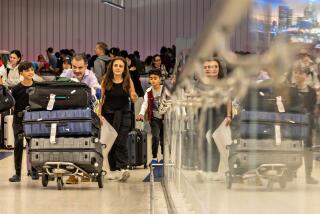Perilous Times on the Tarmac
- Share via
It sounds simple: just one aircraft at a time on an airport runway. But there are several reasons why so-called runway incursions are on an alarming rise in the United States. One of the most prominent is a dramatic surge in air traffic. Last year, takeoffs and landings rose to 68 million at the roughly 460 airports around the nation. Within 10 years, commercial aviation traffic will further increase by more than one-third and general aviation by more than 20%.
There have been 151 runway incursions nationwide through May of this year, a 28% increase over last year, and the 1999 figure represented a 71% rise over 1993.
“This significant growth [in air travel] at virtually the same airport capacity that we use today will only make our job to improve runway safety even more important and more pressing,” said Jane Garvey, head of the Federal Aviation Administration, who likens civil aviation as a carrier today to the Greyhound bus line of old.
She’s right. The FAA has much to accomplish, and dealing with runway incursions, in which one aircraft crosses the path of another, has topped the National Transportation Safety Board’s “to do” list for a decade. The problem is particularly acute at Los Angeles International Airport, John Wayne Airport and other Southern California facilities. Improved technology, new restrictions on airline pilots’ ground movements and increased emphasis on basic safety are crucial, but still more is needed to address the fundamental issue.
Almost every problem in the aviation industry--the delays, the strain on maintenance operations, the runway incursions--has roots in a system bursting at the seams. Significant change won’t come without new policies at the federal, state and local levels, changes that not only acknowledge the pressing need for more airports but for expanded operations at existing facilities.
Federal officials plan to try out at various California airports a new radar system to thwart runway incursions, but even that could fall short. It’s time for the government to ask some basic questions. Is it capable of contracting, deploying and properly using high technology? Is it too reliant on unproven technology? The FAA’s highly touted, 10-years-in-the-making early-warning radar system has fallen far short of expectations. Progress is halting, and new initiatives from the National Transportation Safety Board may add to delays.
One, for instance, would require specific permission from an air traffic controller before an aircraft would be allowed to cross a runway. Airlines may find such a delay unacceptable, but until greater safety can be established on the runways, the carriers press their schedules at increasing risk. Every near-collision is an example of a system under tremendous strain. It can’t be full speed ahead anymore without significant changes.
More to Read
Inside the business of entertainment
The Wide Shot brings you news, analysis and insights on everything from streaming wars to production — and what it all means for the future.
You may occasionally receive promotional content from the Los Angeles Times.










